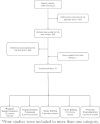Implementation Processes and Pay for Performance in Healthcare: A Systematic Review
- PMID: 26951276
- PMCID: PMC4803682
- DOI: 10.1007/s11606-015-3567-0
Implementation Processes and Pay for Performance in Healthcare: A Systematic Review
Abstract
Background: Over the last decade, various pay-for-performance (P4P) programs have been implemented to improve quality in health systems, including the VHA. P4P programs are complex, and their effects may vary by design, context, and other implementation processes. We conducted a systematic review and key informant (KI) interviews to better understand the implementation factors that modify the effectiveness of P4P.
Methods: We searched PubMed, PsycINFO, and CINAHL through April 2014, and reviewed reference lists. We included trials and observational studies of P4P implementation. Two investigators abstracted data and assessed study quality. We interviewed P4P researchers to gain further insight.
Results: Among 1363 titles and abstracts, we selected 509 for full-text review, and included 41 primary studies. Of these 41 studies, 33 examined P4P programs in ambulatory settings, 7 targeted hospitals, and 1 study applied to nursing homes. Related to implementation, 13 studies examined program design, 8 examined implementation processes, 6 the outer setting, 18 the inner setting, and 5 provider characteristics. Results suggest the importance of considering underlying payment models and using statistically stringent methods of composite measure development, and ensuring that high-quality care will be maintained after incentive removal. We found no conclusive evidence that provider or practice characteristics relate to P4P effectiveness. Interviews with 14 KIs supported limited evidence that effective P4P program measures should be aligned with organizational goals, that incentive structures should be carefully considered, and that factors such as a strong infrastructure and public reporting may have a large influence.
Discussion: There is limited evidence from which to draw firm conclusions related to P4P implementation. Findings from studies and KI interviews suggest that P4P programs should undergo regular evaluation and should target areas of poor performance. Additionally, measures and incentives should align with organizational priorities, and programs should allow for changes over time in response to data and provider input.
Keywords: financial incentives; implementation; pay for performance; performance metrics; systematic review.
Conflict of interest statement
Funding
This project was funded by the U.S. Department of Veterans Affairs, Veterans Health Administration (VHA) ESP Project #05-225.
Prior Presentation
The contents of this manuscript have not been presented at any conference.
Conflict of Interest
The authors declare that they have no conflict of interest, financial or otherwise, to disclose in relation to the content of this paper. Funding for the VA ESP is provided by the VHA Quality Enhancement Research Initiative (QUERI), Health Services Research and Development Service (HSR&D). The Department of Veterans Affairs had no role in the conduct of the study, in the collection, management, analysis, or interpretation of the data, or in the preparation of the manuscript. The views expressed in this article are those of the authors and do not necessarily represent the views of the Department of Veterans Affairs or the U.S. government.
Figures
References
-
- Department of Veterans Affairs. Department of Veterans Affairs Health Care Personnel Enhancement Act of 20042004. - PubMed
-
- United States Government Accountability Office. VA Health Care. Actions needed to improve administration of the provider performance pay and award systems: Report to congressional requesters. 2013.
Publication types
MeSH terms
Grants and funding
LinkOut - more resources
Full Text Sources
Other Literature Sources
Medical
Miscellaneous



